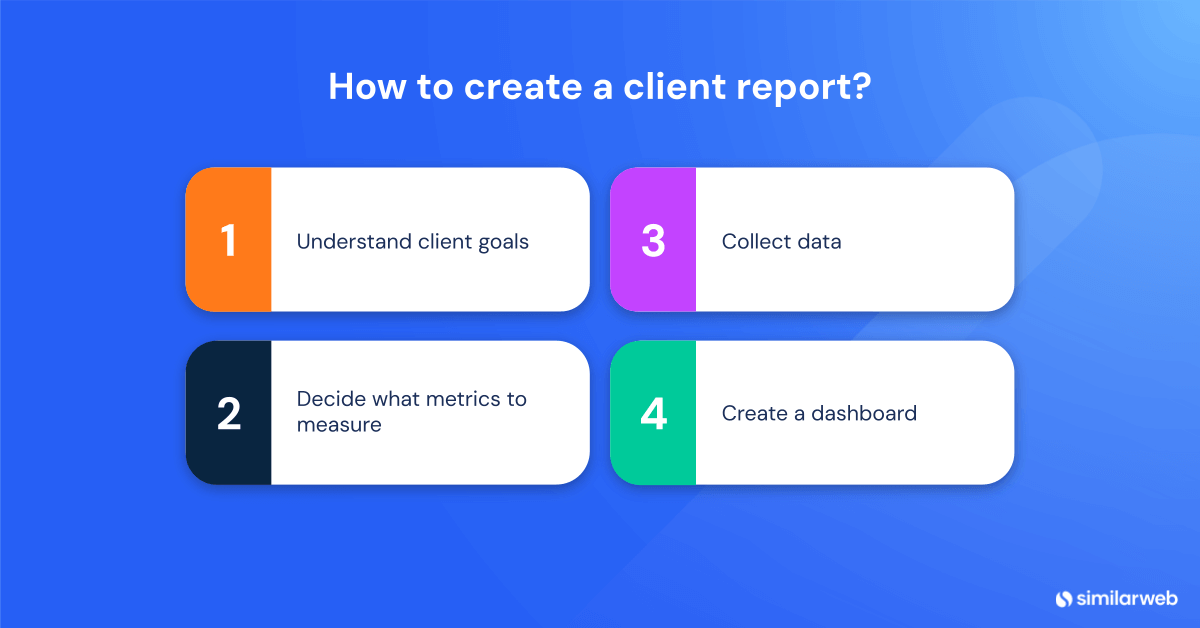Client Reporting: Definition, Purpose, and How to Get Started

Maintaining strong relationships with customers is just as important in marketing as running successful campaigns. For instance, if you work at a marketing agency, showcasing the results your team has achieved for a client is essential to building trust and demonstrating value.
This is where client reporting becomes invaluable—not merely compiling data, but transforming it into a compelling narrative that resonates with clients.
In this post, we’ll get into what client reporting is and how you can get started.
What is client reporting?
Client reporting involves gathering and sharing data to demonstrate how marketing efforts align with and support business objectives. It serves as a communication channel between agencies and clients, offering insights into successes and areas for improvement. These reports often include performance indicators such as website traffic and social media engagement metrics, providing clients with a comprehensive overview of their campaigns’ performance.
Transparency is crucial in client reporting, as it fosters trust through thorough reviews of the services provided. These reports distill complex data into easily digestible information, delivered in formats such as PDFs, spreadsheets, or customized reporting dashboards tailored to client needs.
How to create a client report?
Making a great client report requires taking into consideration what the client wants to achieve. Think strategically to improve customer interaction and satisfaction in these ways:
1. Understand your client’s goals
The foundation of any effective client report is a clear understanding of what the client wants to achieve. Whether the goal is increasing brand awareness, boosting conversion rates, or leveraging the right SEO strategies, you need to identify these priorities early on. Detailed conversations from the start help ensure reports are aligned with client objectives and pave the way for measurable, actionable strategies. By learning about target demographics, budgets, and desired outcomes, agencies can craft strategies tailored to their clients while fostering transparent communication and mutual understanding.
2. Choose metrics that align with performance goals
Selecting the right metrics is critical to demonstrating meaningful progress. For example, if the focus is on SEO performance, keyword research tools and on-page SEO analysis are invaluable. On the other hand, social media metrics may be more relevant for campaigns targeting engagement. Aligning these metrics with KPIs, such as website traffic or lead conversions, ensures that the report provides a clear and comprehensive view of progress. Agencies that skillfully map client visions to specific metrics not only validate their efforts but also demonstrate their commitment to delivering results.
3. Collect data using Similarweb website analysis tool
Data collection is necessary for creating a compelling client report. Similarweb Website Analysis tool enables you to get a comprehensive snapshot of website traffic and domain activity, which is crucial to performance data.
Clients value these reports for their relevance and ability to address specific issues. Each piece of data contributes to a cohesive narrative that resonates with clients, offering strategic insights to support better decision-making and deeper understanding.
4. Create a report with Similarweb dashboard template tool
The next step is to crunch the data, and then present it in an interesting format. Similarweb’s Dashboard Template tool translates insights into attractive reports by embedding metrics in value-telling stories.
Prioritizing stories helps make sure every bit of data adds up to something larger and allows customers to connect measures such as SEO with individual results. It is an approach that strengthens decision-making and instills trust between the agency and the client.
5 tips for a useful client report
A compelling client report is essential for fostering strong agency-client relationships. These reports should go beyond presenting data—they should serve as tools for collaboration and strategic growth. Here are five tips to elevate your client reports and make them indispensable resources:
1. Leverage automated client reporting tools
Automated client reporting tools have changed the way reports are written. By seamlessly aggregating information from multiple sources, these tools consolidate SEO audits, site analytics, and other metrics into a unified dashboard. This integration isn’t just visually appealing—it enhances readability and supports decision-making.
Emerging technologies like artificial intelligence and machine learning make these tools even more powerful by detecting patterns early and offering actionable recommendations. Automated systems deliver precision and build trust, both of which are critical for successful agency-client partnerships.
2. Keep it simple
Reports should be clear and easy for customers to understand. When you strip the data and dive into metrics that matter, like keyword rankings and SEO, you make this information more accessible. Visual aids such as charts and bullets can help you make messages clearer and digestible.
A well-structured report not only simplifies communication but also encourages proactive client engagement. Clarity fosters trust and allows clients to focus on actionable insights rather than feeling overwhelmed by numbers, strengthening collaboration between you and your clients.
3. Share both successes and failures
An honest report includes both achievements and areas needing improvement. Being transparent about what worked and what didn’t opens the door to productive conversations with clients. This balance allows you to evaluate which strategies to maintain and which require adjustment.
Transparency fosters trust and mutual respect, making it easier to refine tactics and emphasize accountability. It also reinforces a shared commitment to the client’s success, strengthening the relationship over time.
4. Provide actionable insights
The best reports go beyond presenting data—they translate it into insights that drive action. Use tools that provide detailed analytics or conduct comprehensive SEO audits to identify opportunities and offer strategic recommendations tailored to the client’s goals.
Instead of delivering just an overview, focus on providing clear, step-by-step guidance that clients can act on. This approach not only motivates collaboration but also ensures that both agency and client are working towards measurable, impactful outcomes.
5. Customize report for each client
Generic, one-size-fits-all reports don’t meet the unique needs of individual clients. Each report should reflect the client’s specific goals, whether they involve increasing website traffic, optimizing content, or improving conversion rates.
Tailored reports demonstrate a deep understanding of the client’s needs and challenges, fostering meaningful discussions during review meetings. Customization ensures that reports are relevant, purposeful, and aligned with the client’s objectives, making them far more impactful.
Bridge the divide between raw data and compelling stories
For marketing professionals, bridging the gap between raw data and meaningful narratives is key to fostering mutual understanding and building stronger client relationships. Transparency and data-driven decisions stem from well-structured reporting. While a compelling narrative needs reliable data to back it up, tools like Similarweb’s Website Analysis and Dashboard Template can elevate your reporting process.
Leverage these tools to uncover the value within your data and create custom reports that resonate with your clients, delivering insights that drive actionable results and strengthen your partnerships.
FAQs
How often should we generate client reports?
The frequency of client reports depends on the specific campaign requirements and client preferences. Some clients may prefer weekly summaries, while others opt for monthly or quarterly reports. For those requiring frequent updates, real-time dashboards provide continuous insights, allowing clients to track campaign performance at any time.
How can client reports be personalized?
Personalization involves selecting metrics that align with the client’s goals and addressing their specific pain points. By understanding their business objectives and focusing on key performance indicators (KPIs), agencies can create reports that facilitate clear communication. Customizations in visualization, branding, and language further enhance clarity, making it easier for clients to interpret the data.
Why is transparency important in client reports?
Transparency fosters trust and confidence between agencies and clients. Openly sharing performance data and addressing challenges ensures clients feel informed and involved. Explaining data patterns and trends builds rapport and creates a foundation for collaboration, enabling both parties to address issues effectively and improve outcomes.
What are the benefits of well-designed client reporting?
A well-designed client report strengthens relationships by clearly linking marketing activities to business outcomes. It facilitates effective communication, supports data-driven decisions, and highlights progress and accountability. These reports build long-term trust, demonstrate responsibility, and empower clients to collaborate more effectively with their agency.
What tools are useful for creating client reports?
Tools like dashboards, data collection applications, and visualization platforms are essential for creating effective client reports. Automated systems, data integration capabilities, and customizable templates improve accuracy, efficiency, and clarity. Selecting tools that align with both agency and client needs ensures the creation of impactful reports.
Your full marketing toolkit for a winning strategy
The ultimate solution to help you build the best digital strategy











